Zone
Crash of a Beechcraft A60 Duke in Minidoka
Date & Time:
Aug 13, 2009 at 1541 LT
Registration:
N99BE
Survivors:
Yes
Schedule:
Pocatello – Boise
MSN:
P-132
YOM:
1970
Crew on board:
1
Crew fatalities:
Pax on board:
1
Pax fatalities:
Other fatalities:
Total fatalities:
0
Captain / Total hours on type:
800.00
Aircraft flight hours:
3120
Circumstances:
The pilot reported that he planned to fly a round trip cross-country flight. Prior to takeoff, he ascertained the quantity of fuel on board based upon the airplane's fuel totalizer gauge indication, which indicated 89 gallons. The flight to the destination was uneventful, and upon landing, 20 gallons of fuel was purchased. Thereafter, the pilot departed for the return flight back to his originating airport. According to the pilot, on takeoff the fuel tank gauges indicated the tanks were between 1/3 and 1/4 full. While cruising, the pilot contacted an air traffic control facility and notified them that he had lost power in one engine. About 5 minutes later, the pilot broadcasted that both engines were without power. Unable to reach the nearest airport, the pilot landed on soft, uneven terrain. During rollout, the airplane nosed over and was substantially damaged. The calculated post accident fuel burn-off for the round trip flight was about 106 gallons. During the post accident inspection, an FAA inspector reported finding an estimated 2 gallons of fuel in one tank. The other tank was dry. No fuel was observed in the main fuel lines to the engines, and no mechanical malfunctions were reported by the pilot.
Probable cause:
A loss of engine power due to fuel exhaustion as a result of the pilot's inadequate fuel planning.
Final Report:
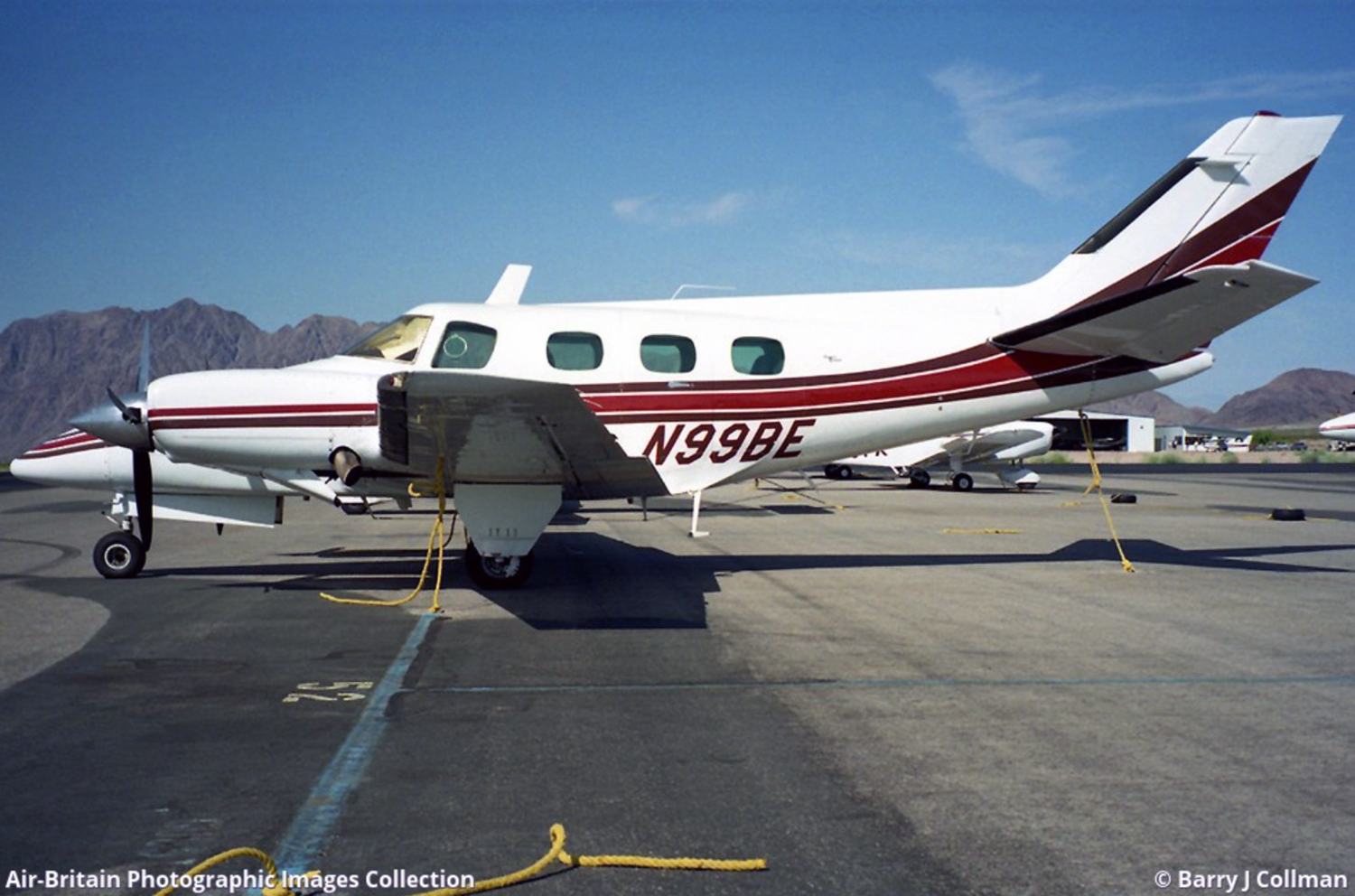
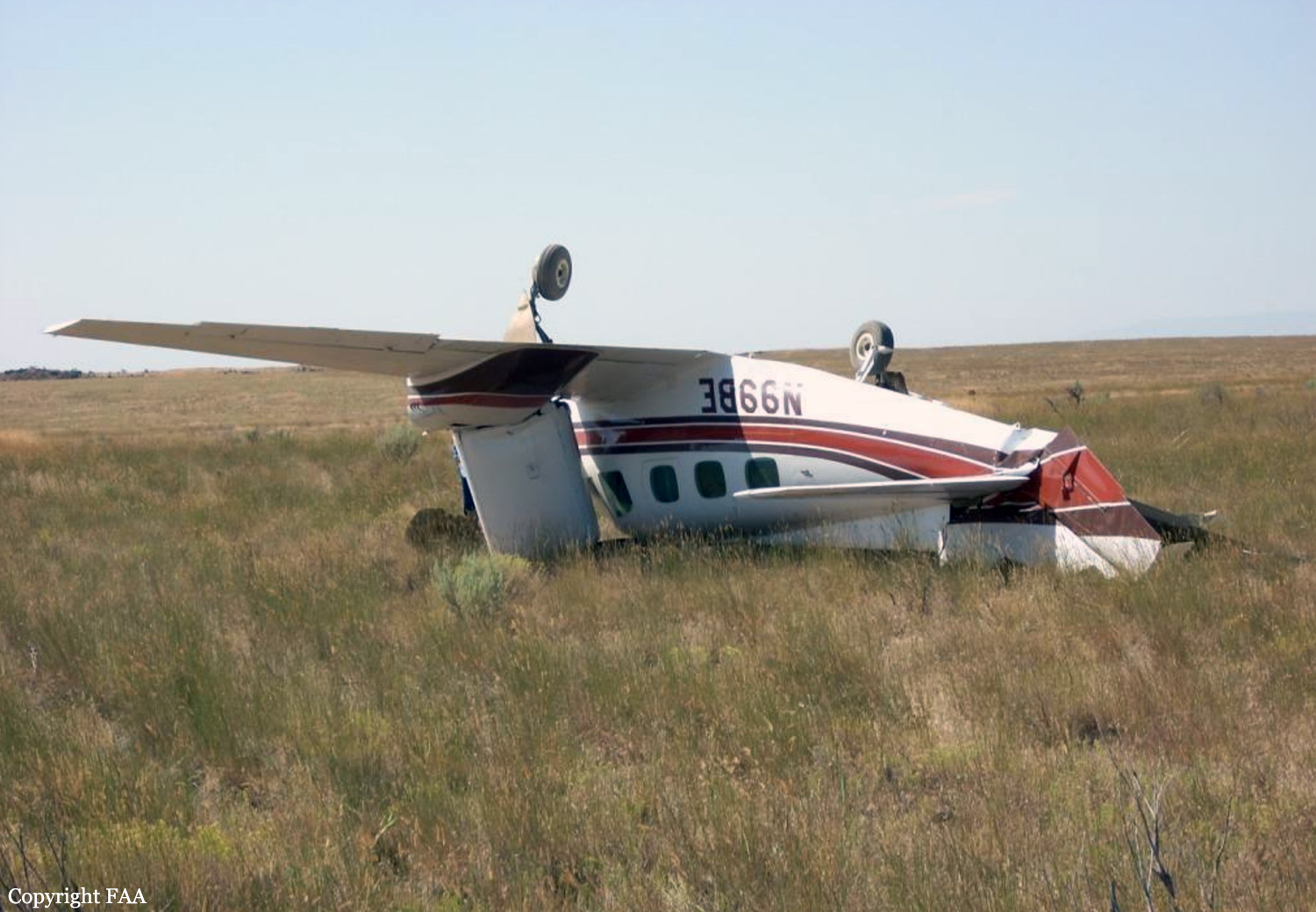

Crash of a Mitsubishi MU-2B-36 Marquise in Malad City: 8 killed
Date & Time:
Jan 15, 1996 at 0618 LT
Registration:
N693PA
Survivors:
No
Schedule:
Salt Lake City - Pocatello
MSN:
693
YOM:
1977
Crew on board:
2
Crew fatalities:
Pax on board:
6
Pax fatalities:
Other fatalities:
Total fatalities:
8
Captain / Total hours on type:
1200.00
Circumstances:
A Mitsubishi MU-2 departed Salt Lake City, Utah, and climbed to 16,000 feet MS on an IFR flight to Pocatello, Idaho. While in cruise flight, the MU-2 encountered structural icing conditions. According to radar data, the MU-2 began slowing from a cruise speed of about 190 knots with slight deviations from heading and altitude. The airspeed decreased to about 100 knots, and the flight crew declared an unspecified emergency, then radio contact was lost. The MU-2 began a right turn, then it entered a steep descent and crashed. The pilot of a Beech 1900 (about 12 minutes in trail of the MU-2), stated that he encountered moderate rime icing at 16,000 feet. The Beech pilot activated his deice boots (3 times) and descended to 12,000 feet to exit the icing conditions. The MU-2 flight manual warned that during flight in icing conditions, stall warning devices may not be accurate and should not be relied upon; and to minimize ice accumulation, maintain a minimum cruise speed of 180 knots or exit the icing conditions. An investigation determined that the captain of the MU-2 was aware of deficiencies in the timer for the deice boots, as well as other maintenance deficiencies. The captain's medical certificate was dated 11/17/94; he was providing executive transportation for compensation under an agreement for "contractual flights," under 14 CFR 91. Although icing conditions were forecast in the destination area, no icing was forecast for the en route portion of the flight.
Probable cause:
Continued flight by the flightcrew into icing conditions with known faulty deice equipment; structural (airframe) ice; and failure of the flight crew to maintain adequate airspeed, which resulted in the loss of aircraft control and collision with terrain. A factor relating to the accident was: the en route weather (icing) condition, which was not forecast (inaccurate forecast).
Final Report:

Crash of a Cessna 402B in Boise: 2 killed
Date & Time:
Nov 16, 1991 at 0256 LT
Registration:
N29517
Survivors:
No
Schedule:
Boise - Pocatello
MSN:
402B-0031
YOM:
1970
Crew on board:
1
Crew fatalities:
Pax on board:
1
Pax fatalities:
Other fatalities:
Total fatalities:
2
Captain / Total hours on type:
450.00
Aircraft flight hours:
6994
Circumstances:
The pilot announced he had an engine failure during initial climb at 300-400 feet agl after takeoff on a VFR night cargo flight. The tower controller cleared the flight to return to the airport and land on any runway. The aircraft entered a right descending turn, impacted the ground one mile from the airport, and ignited in flames. Evidence indicated the right engine was not operating at impact. The landing gear was down and the right propeller was in the high pitch position. Exam of the right engine revealed blocked fuel injectors, incorrect size fuel injectors, fuel pump out of adjustment, and burned/pitted breaker points in a magneto. Both occupants were killed.
Probable cause:
The loss of power on the right engine during initial climb after takeoff due to inadequate maintenance inspection and adjustment of the engine by company maintenance personnel, and the loss of control by the pilot due to his failure to properly configure the aircraft and perform a proper single engine climb maneuver, and his failure to maintain single engine climb airspeed. A factor relating to the accident was the dark night light conditions.
Final Report:
Crash of a Piper PA-61 Aerostar (Ted Smith 601) in Santa Ana: 5 killed
Date & Time:
Mar 31, 1989 at 0835 LT
Registration:
C-GWPS
Survivors:
No
Schedule:
Santa Ana – Pocatello – Camrose
MSN:
61-0522-219
YOM:
1978
Crew on board:
1
Crew fatalities:
Pax on board:
4
Pax fatalities:
Other fatalities:
Total fatalities:
5
Captain / Total hours on type:
243.00
Aircraft flight hours:
1908
Circumstances:
Several mechanic witnesses at the airport said the right engine backfired and trailed black smoke during the takeoff ground roll. Reportedly, the takeoff roll was about 80% longer than normal. Witnesses said the aircraft staggered off the ground, was slow and never got above 100 feet agl. The pilot reported to the tower that the flight had to come back to the runway. Shortly thereafter, witnesses saw the aircraft enter a steep left turn, apparently stall, then crash into some tennis courts. An investigation revealed evidence that the right engine had lost power. A modification kit for the fuel injector reference air lines was incorrectly installed and allowed an unfiltered air source. Spectral analysis of residue (from the right engine turbocharger compressor) revealed that it had the same composition as the alternate air door seal. Traces of the material were found in the fuel injector reference air line. All five occupants were killed.
Probable cause:
Failure of the pilot to attain adequate airspeed before maneuvering (turning) back toward the airport, which resulted in a loss of aircraft control. A factor related to the accident was: improper maintenance/installation of a fuel injector reference air line, which allowed contamination of the injectors and loss of power in the right engine.
Final Report:
Crash of a Swearingen SA226TC Metro II in Salt Lake City: 8 killed
Date & Time:
Jan 15, 1987 at 1252 LT
Registration:
N163SW
Survivors:
No
Schedule:
Pocatello - Salt Lake City
MSN:
TC-327
YOM:
1980
Flight number:
OO1834
Crew on board:
2
Crew fatalities:
Pax on board:
6
Pax fatalities:
Other fatalities:
Total fatalities:
8
Captain / Total hours on type:
1863.00
Copilot / Total hours on type:
1205
Aircraft flight hours:
15116
Circumstances:
On January 15, 1987, at 1216 mountain standard time, SkyWest flight 1834, a Fairchild Swearingen SA-226TC (METRO II), registration Nl635W, departed Pocatello, Idaho, on a regularly scheduled passenger flight to Salt Lake City, Utah (SLC). The flight was operating under the provisions of Title 14 Code of Federal Regulations Part 121 with two pilots and six passengers aboard. Flight 1834 was handed off from the SLC Air Route Traffic Control Center to the Bear Sector controller at the SLC Terminal Radar Approach Control (TRACON) for a left downwind arrival to SLC International Airport. At 1237:49, the Bear sector controller issued a heading of 100” to flight 1834 and advised the flight to expect vectors for a visual approach to runway 34L. (See Air Traffic Control Transcript in appendix C). During the next few minutes, flight 1834 was given further vectors and descent clearances, and at 1247:21, it was given a frequency change to the TRACON Final controller. At 1250:28, after being cleared to descend to 7,000 feet mean sea level (msl), the Final controller advised, “SkyWest eight thirty four, traffic ten to nine o’clock, four miles, six thousand, Boeing seven, ah, thirty seven three hundred.” Flight 1834 acknowledged, “SkyWest eight thirty four has the traffic.” At 1250:35, the Final controller advised, “SkyWest eight thirty four, plan to follow that traffic, there’s traffic south of him eleven o’clock, six miles north bound, [a] seven thirty seven out of seven thousand five hundred, for the right.” Flight 1834 responded, “OK, we’ll follow the first one, SkyWest eight thirty four.” At 1250:44, the Final controller advised, “SkyWest eight thirty four, wait a minute, report the other one in sight.” Flight 1834 responded, “We’re looking for him.” At 1251:02, the Final controller transmitted, “SkyWest eight thirty four, ten o’clock four miles, seven thousand four hundred.” Flight 1834 replied, “Eight thirty four, we’re looking.” The Final controller then issued instructions at 1251: 15 for flight 1834 to make a left turn to 070”, and the flight acknowledged. At 1251:32, the Final controller transmitted, “SkyWest eight thirty four, traffic’s ten to eleven o’clock, three miles.” Flight 1834 did not acknowledge that transmission, and at 1251:43, the Final controller advised, “SkyWest eight thirty four, turn left heading zero five zero.” The flight acknowledged and reported, “Still have no contact on that traffic.” At 1251:50, the Final controller transmitted, “SkyWest eight thirty four, roger, turn further left heading three six zero.” Flight 1834 acknowledged and at 1251:58, an expletive was transmitted over the TRACON Final control frequency during a transmission from SkyWest flight 575. There were no further transmissions from flight 1834. According to the UNICOM I/ operator at SLC Municipal 2 Airport (SLC 2) about 1115 or 1120, a pilot in Mooney M20C, registration N6485U, operating under 14 CFR Part 91, called to inquire if the runway was clear. The Mooney was occupied by a private pilot in the left seat and an instructor pilot in the right seat. The UNICOM operator advised that the runway was clear, and a few minutes later, a pilot in the Mooney called for and was given an airport advisory. The UNICOM operator observed the Mooney taxi to runway 34 and take off about 1125 or 1130. The Mooney remained in the traffic pattern at SLC 2 performing touch-and-go landings. There were no other aircraft in the traffic pattern at the time. The UNICOM operator stated that she last talked to the Mooney about 1145 to 1150 when a pilot called, “Final for 34.” The UNICOM operator said that she observed the airplane perform a touch-and: go landing, but she did not observe the direction of departure of the airplane. There were no further known communications with the Mooney regarding departing the traffic pattern or any additional aspects of the flight. According to recorded air traffic control (ATC) radar data, after the Mooney departed the SLC 2 traffic pattern at 1235, y the airplane flew south and maneuvered about 25 miles south southeast of SLC International Airport before beginning a turn to the northwest. The airplane continued in a northwesterly direction until it was about 9 miles south of SLC International Airport where it began a gradual left turn until its target merged with the target of SkyWest flight 1834. The targets merged at 1257 :58--the time the expletive was recorded on the ATC tape at the SLC TRACON. The Final approach controller stated that he did observe a visual flight rules (VFR) target about 3 to 4 miles southwest of SLC 2 moving north to northwest when flight 1834 was on downwind. He said he had no more than normal cause to monitor the target. He also stated that it was not unusual to observe VFR targets in the pattern near SLC 2 during visual meteorological conditions. Other controllers at SLC TRACON also stated that it was not uncommon to observe numerous targets operating in the traffic pattern at SLC 2. The Final controller and other controllers added that they normally would observe the VFR targets near SLC 2 disappear from the radarscope and then reappear during practice touch-and-go landings. The Final controller said that he did not recall seeing any VFR targets in the vicinity of SkyWest 1834 as it was turning toward final just before the collision. The Fin.al controller stated that his workload was moderate, and all of his equipment was operating normally before the accident. In addition, the Local controller in the SLC tower stated that he did not observe the target of the Mooney on the tower Bright Radar Indicator Tower Equipment display. There was no evidence that the Mooney pilots were in radio contact with any ATC facility at the time of the accident. Several eyewitnesses were interviewed who observed the airplanes before and after the collision. Some of the witnesses stated that the nose of the METRO II pitched up just before impact. The witnesses stated that the METRO II was headed northeasterly and the Mooney was headed northwesterly just before impact. They stated that the METRO II had made a few left turns as it turned toward the northeast. In general, the eyewitnesses agreed that the two airplanes collided with the Mooney striking the METRO II’s right forward fuselage area with its nose. After the collision, both airplanes fell to the ground with wreckage scattered over 2 square miles in a residential section of Kearns, Utah. There was no fire. The collision occurred at 7,000 feet msl in daylight visual meteorological conditions. All 10 occupants in both aircraft were killed. There were no casualties on the ground.
Probable cause:
Lack of navigational vigilance by the Mooney instructor pilot which led to the authorized intrusion into the Salt Lake City airport radar service area. Contributing to the accident were the absence of a Mode-C transponder on the Mooney airplane and the limitations of the air traffic control system to provide collision protection under the circumstances of this accident.
Final Report:
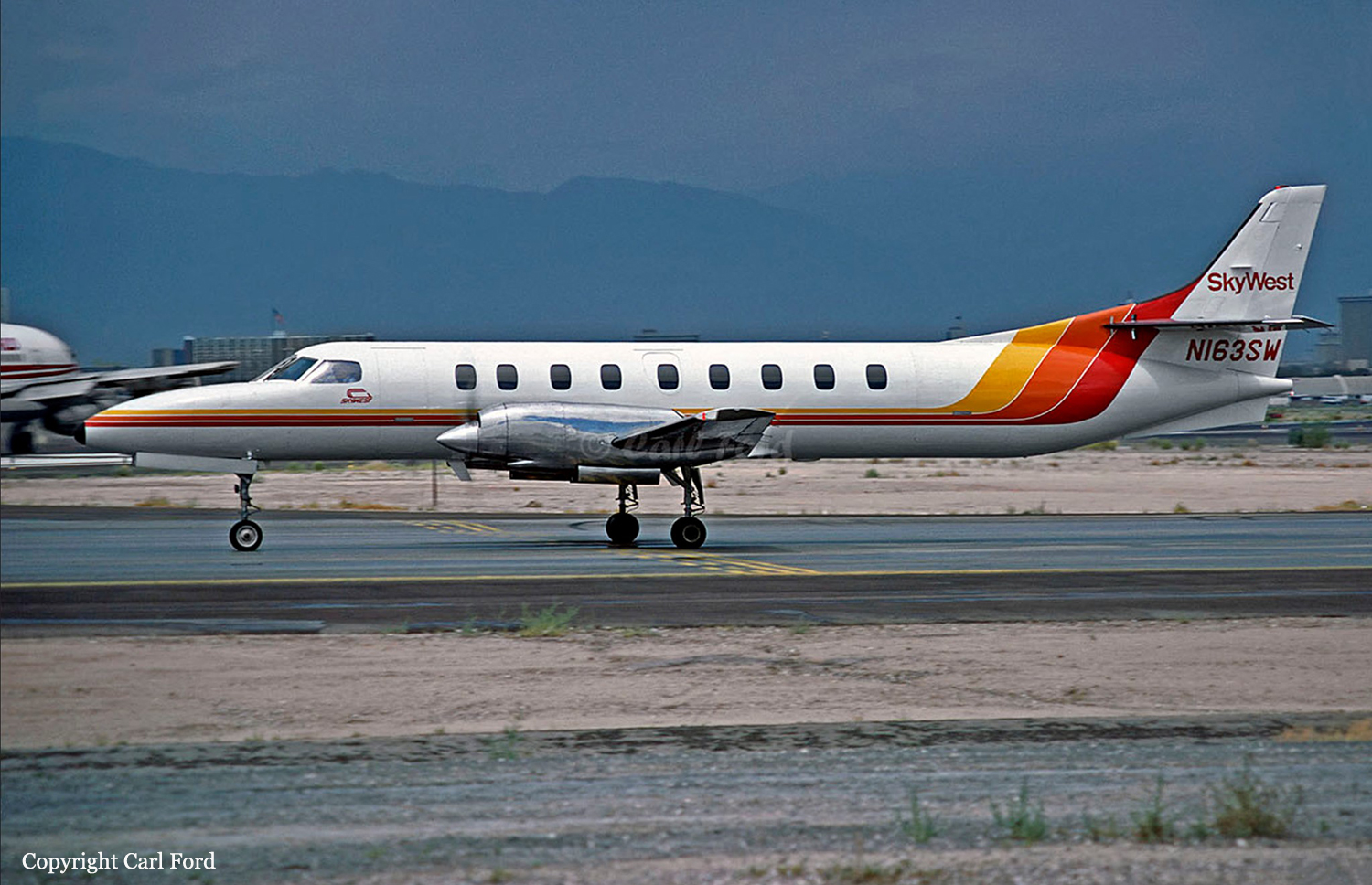
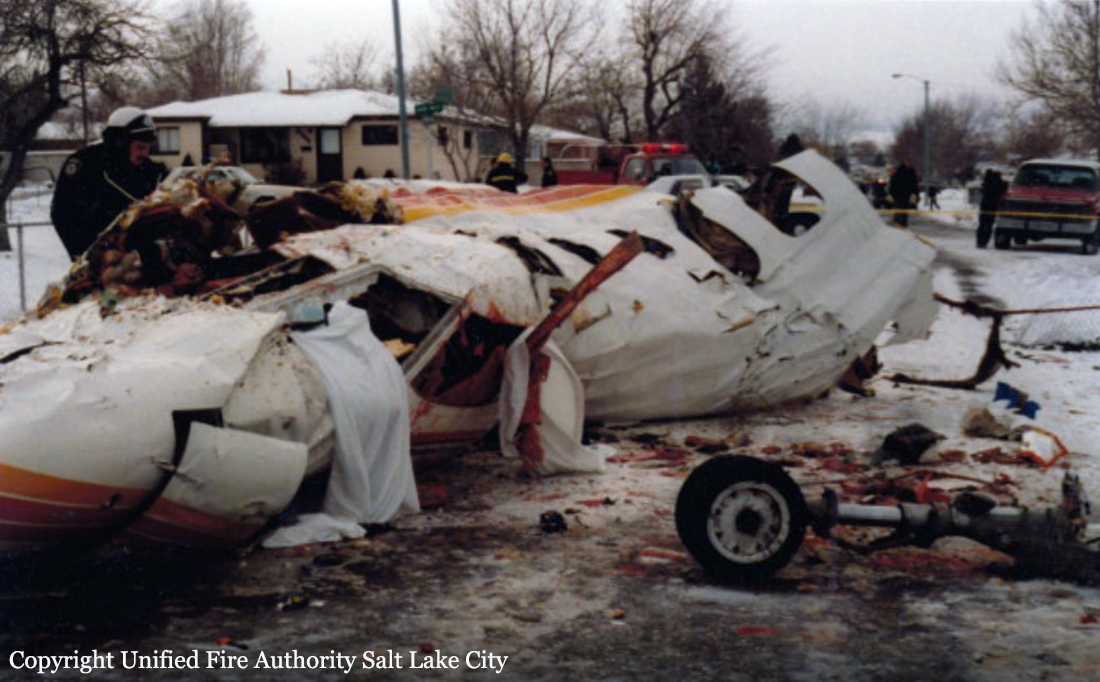
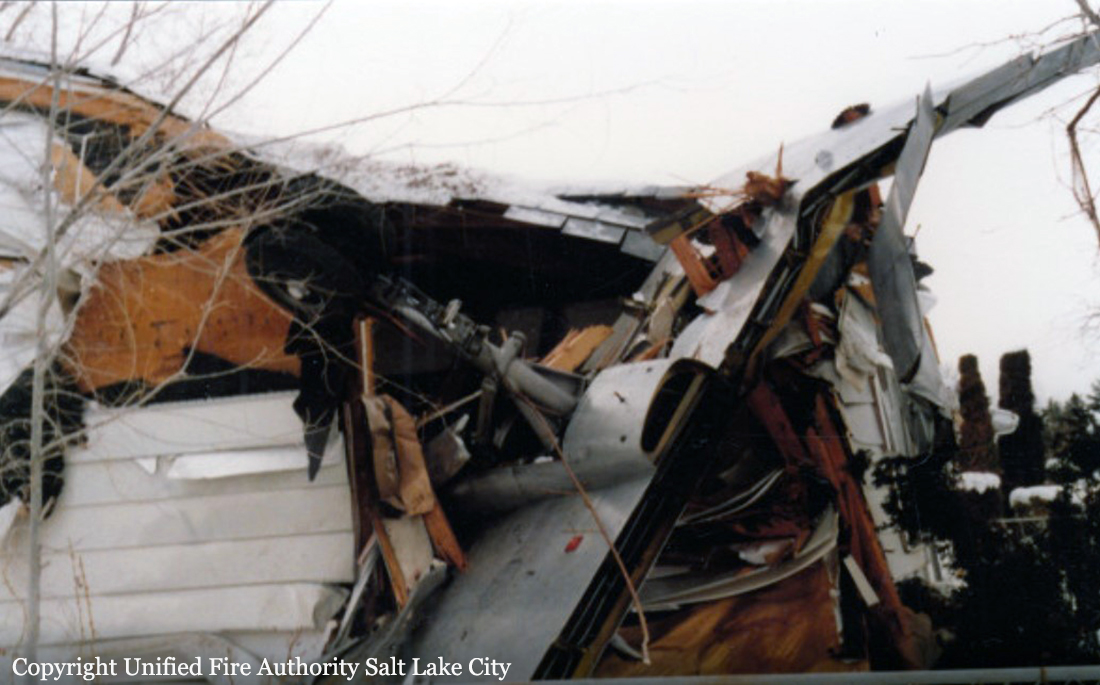
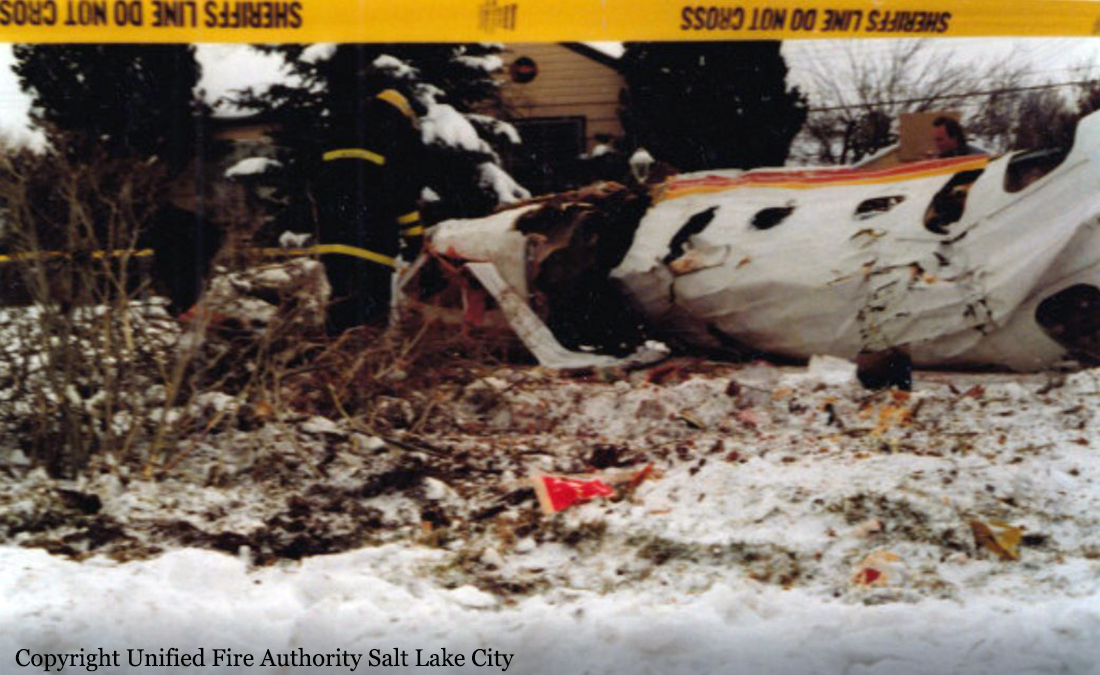
Crash of a Cessna 402 in Pocatello: 1 killed
Date & Time:
May 15, 1985 at 1826 LT
Registration:
N402CS
Survivors:
No
Schedule:
Pocatello - Boise
MSN:
402A-0108
YOM:
1969
Crew on board:
1
Crew fatalities:
Pax on board:
0
Pax fatalities:
Other fatalities:
Total fatalities:
1
Captain / Total hours on type:
350.00
Circumstances:
Shortly after departure and level off, the pilot reported an engine malfunction and initiated a return to the airport. About 2 minutes later, he reported an engine fire and declared an emergency. Approximately one minute thereafter, the right wing separated from the aircraft and the plane crashed. An exam of the wreckage revealed extensive inflight fire damage in the area of separation. A 2.5 by 3 inches hole was found in the right inboard exhaust tube, pn 0850712-6. It was oriented toward the accessory compartment with numerous fuel and oil lines which were fire damaged and charred. Also, much of the engine support structure and wing spar were melted in that area. An exam of the exhaust tube revealed its walls were thin, brittle and discolored in the area of the rupture and several areas of cracks and small holes were found. The exhaust tube had 5,862 hours of total service and 1,762 hours since it was overhauled. Records showed that ad 75-23-08 had been complied with during the last inspection, 25 flight hours prior to the accident. The pilot, sole on board, was killed.
Probable cause:
Occurrence #1: airframe/component/system failure/malfunction
Phase of operation: unknown
Findings
1. (c) exhaust system, manifold/pipe - corroded
2. (c) maintenance, inspection - inadequate - company maintenance personnel
3. (f) procedure inadequate - manufacturer
4. (f) inadequate surveillance of operation - faa (organization)
5. (c) exhaust system, manifold/pipe - failure,total
6. (c) exhaust system, manifold/pipe - leak
----------
Occurrence #2: loss of engine power (partial) - mech failure/malf
Phase of operation: cruise - normal
Findings
7. Initiated - pilot in command
----------
Occurrence #3: fire
Phase of operation: descent
Findings
8. (c) miscellaneous - fire
9. Wing, spar - burned
----------
Occurrence #4: airframe/component/system failure/malfunction
Phase of operation: descent
Findings
10. (c) wing - failure, total
11. Wing - separation
----------
Occurrence #5: in flight collision with terrain/water
Phase of operation: descent - uncontrolled
Phase of operation: unknown
Findings
1. (c) exhaust system, manifold/pipe - corroded
2. (c) maintenance, inspection - inadequate - company maintenance personnel
3. (f) procedure inadequate - manufacturer
4. (f) inadequate surveillance of operation - faa (organization)
5. (c) exhaust system, manifold/pipe - failure,total
6. (c) exhaust system, manifold/pipe - leak
----------
Occurrence #2: loss of engine power (partial) - mech failure/malf
Phase of operation: cruise - normal
Findings
7. Initiated - pilot in command
----------
Occurrence #3: fire
Phase of operation: descent
Findings
8. (c) miscellaneous - fire
9. Wing, spar - burned
----------
Occurrence #4: airframe/component/system failure/malfunction
Phase of operation: descent
Findings
10. (c) wing - failure, total
11. Wing - separation
----------
Occurrence #5: in flight collision with terrain/water
Phase of operation: descent - uncontrolled
Final Report:
Crash of a Consolidated B-24J-40-CO Liberator near Idaho Falls: 7 killed
Date & Time:
Jan 8, 1944 at 2040 LT
Registration:
42-73365
Survivors:
No
Schedule:
Pocatello - Pocatello
MSN:
2935
YOM:
1942
Crew on board:
7
Crew fatalities:
Pax on board:
0
Pax fatalities:
Other fatalities:
Total fatalities:
7
Circumstances:
The crew was engaged in a night training flight in the region of Idaho Falls and Pocatello. En route, pilot lost control of the aircraft that crashed in a desert area located some 50 km west of Idaho Falls. All seven crewmen were killed.
Crew:
Richard A. Hedges,
Lonnie L. Keepers,
Robert W. Madsen,
Richard R. Pitzner,
Louis H. Rinke,
Charles W. Eddy,
George H. Pearce Jr.
Crew:
Richard A. Hedges,
Lonnie L. Keepers,
Robert W. Madsen,
Richard R. Pitzner,
Louis H. Rinke,
Charles W. Eddy,
George H. Pearce Jr.



